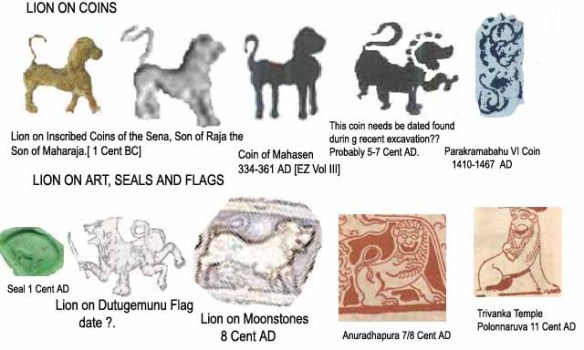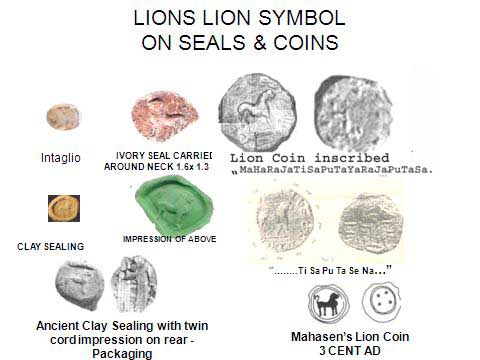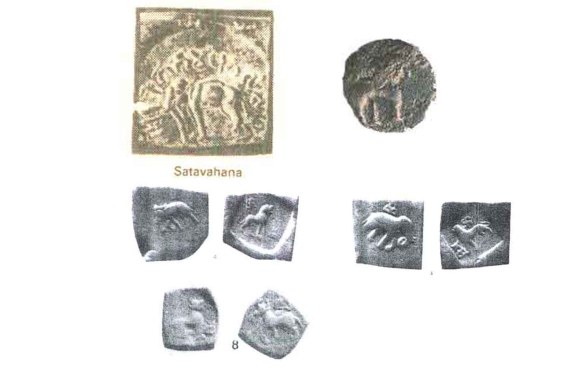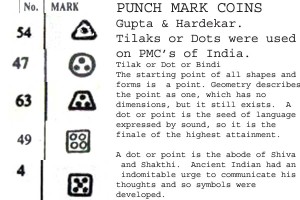LION COINS OF KING MAHASEN
‘ The artist Lion need be like no lion on earth or in any zoological garden; the artist is not preparing the plates of a work on natural history, but makes his lion at once the portrait of the universe and an expression of the whole theory of his national existence.’
– Ananda Coomaraswamy.
The Image of King Mahasen.
The image now believed to be of King Mahasen is at Kirivehera, Kataragama. The figure of kings seems to have been made in the same way as those of Bodhisattvas or aspirant Buddhas. That Kings were treated as Biodhisattvas is confirmed by statement found on inscriptions such as
‘ no bosathu norajavanhai’
“A non-bosat will not become a King”.
The images of ancient Kings as believed by the common people be of Devanampiyatissa[read wordpress.sirimunasiha. King Devanampiayatissa Coin] ] is found at Mihintale, a that of King Dutugemunu[ is at Ravanveli Dagabo Anuradhapura, King Vattagamini Abaya at Dambulla etc. Only Stone image of a king with an inscription reading ‘Tisaraja‘ at the Ruvanweli Dagabo at Anuradhapura. The script belongs to the first century AD and Dr Paranavitane it refers to King Bhatiyatissa I.[Prof TG Kularatna-Mahavihare at Anuradapura].
The Flag of King Mahsen.
In The book – A Reign of Ten Kings by Nalini De Lanerolle a vivid description of King Mahasen and his world is a must read. She has attached a flag of King Mahasen found in a temple at Kundasale
Flags of King Dutugemunu has a similar shape and the Standard or the Sign Manual of (?)Devanampiatissa[P. Weerasunghe RAS J Vol XXXIV 1989/90] . This symbol is now identifuied as the Dhajaya or the Flag and found on the coin of Devanampiyatissa and other early kings of Sri Lanka.Shown below. Read Coins of King Devanampiatissa on Blog wordpress
King No 60. MAHASENA (Maha Sen) 269-296 AD – Brother of Jettha Tissa, younger son of Gothabhaya – a period of religious dissention followed. The Maha Vihara Bhikkus were persecuted and left abandoning the Maha Vihara for 9 years. Lovamahapaya was destroyed. Later the King became reconciled and Maha Vihara was repaired.He built the largest Stupa in Sri Lanka the Jetwanarama.http://www.royalasiaticsociety.lk/research-projects/jethawanaramaya-complex-as-it-looked-in-9th-century-ad/ He built 17 tanks. During the Central Cultural Fund excavation of Jetvanarama , large numbers of the coins were found with the Lion on the obverse. These coins are dated to his period during the Central Cultural Fund explorations, and is now believed that he minted this series of coins in two or three denominations.
The Lion.
The Lion image is quite common in the art and architecture of the Sinhalese. Perhaps the earliest images are those images of a walking Lion found on the Inscribed Pentagonal Coins of the Sinhalese. This coin was found in strata or undisturbed layers of earth at Vijeabahu Palace , carbon dated to 190-100 BC. For more detail go to siriminasiha.wordpress.Railed Swastika Series I – Large Elephant , Lion , Horse and Bo-Tree in Enclosure.
Lion symbol is common to Sinhalese art and were used on their coins from 1 Cent BC to present day currency notes. It represented many aspects in their mind set . The most sacred is the religious aspect ,that it the symbol which represented the message of the Buddha or known as the ‘lions roar’. It may have represented the message of the future Bodhisattvas. The Sinhalese believed all their Kings were future Bodhisattvas. Lion also represented the direction- West. The Lion placed on a face of a coin would easily be reognised by the Sinhalese and readily accepted as currency for trade and exchange. These coin been a piece or art and having religious value would have been used a a good luck pendent, there is one discovery of pierced coin which was used as a pendent amoung hundred of Mahasen lion coins found through out the Island. This shows that his political influence spread through the whole country and his money was accepted by the whole Island. There are finds of ancient coins such as the Maya-devi coins and few gold Roman coins used as pendent having similar holes pierced for hanging around the neck by means of tread.
Perhaps the oldest dated image of the lion in Sri Lanka is found on coins or seals. The rear of the sealants found by the German excavation team at Tissamaharama , had the impression of the Tala leaf used for writing on is noticed. They may well have been important documents to have the symbol on the coins l of rulers placed on them. Can we speculate them to be credit notes or some form of money with the authority of the ruler making them valid and accepted by all?.For Tala Leaf Accounting Systems of Ancient Sri Lanka.[ Click ]
“Kahapanas are either of Gold or Silver of the common metal. The metal Masaka is the masaka made of copper and the like; the wooden masaka is of masaka made of sara wood,or the outside of bamboo or even Tala leaf on which an image is cut.”- Samantapasadika Atthakatha Buddhagosha 5 Cent AD.
The lion appears on a coin of Anuradhapura period with the Pot standing on three lines flanked by two Lamps [ Dipa]. The Three lines are characteristic of the large numbers of Maya-devi coins found in Sri Lanka. The two lamps are also found on the Type I Kalandas of Gold series of later Anuradhapura period.
Similar Lions are found on ancient art of the Sinhalese, most famous of these are that on the King Dutugemunu flag, seen on a cave painting at Dambulla.This is similsr to the present Sri Lankan flag.These caves date back to King Devanampiyatissa and there is inscription and other evidence from King Sadatissa to the king Kirthi Sri Rajasinghe.at Dambulla. Some of the statues show stylistic resemblance to those of the Anuradhapura period[2-3 Cent AD]. Lion is on most of the moon-stone at Anuradhapura.
A squatting Lion was reintroduced almost 900 years later by King Parakramabahu VI of Kotteon his coin. Read Lion Coins of Parakramabahu VI Coin.
The lion symbol is found on Coins of few Janapadas of ancient India
The 4 Dots or Golas.
The reverse of the coin is different to the coins of the earlier kings which had the Railed Swastika on the reverse. This coins has four Dots[ Thilakas] or Golas in a circle on the reverse.See below. The other Sinhala coins of this period also followed this same pattern in the Rectangular Bull Coins of 3/4 cent sinhalese kings, others smaller denominations had a single Thilka in a triangle. The tree dots are used in Elephant & Railed Swastika large , Tree and Swastika etc coin on both sides in between the other symbols. Dot from 1 to 8 numbers are common symbols on the silver kahapanas[ PMC’s- read below] The Gold series and then Dambedeniya coins used the four Golas too on the obverse of the coin. Dr Paranavitane gave an explanation for the use of this symbol to phonetically mean Pala-Pancha. – Story of Sigiriya. More details on Kalandas of Gold go to Sirimunasiha.wordpress.THE GOLD COINAGE OF SRI LANKA– the Coinage of the Kings of the Manavamma[668-703 AD] Dynasty up to Mahinda V[981-1017 AD.
What is now believed to be of King Mahasen’s statue shown above is worshiped at Kirivehera , Kataragama.
DEVELOPMENTS IN SRI LANKA DURING 1-4 CENTURY AD.-LAMBKANNA DYNASTY
The following direct evidence in found on inscriptions during this period.
AS Hettiarachchi[ Section II- INSCRIPTIONS VOLUME II-1990].A special feature of the inscriptions written in the 2nd, 3rd and 4th centuries is the occurrence
- Numbers: or Numerals are written as figures used during that time. These figures are close to that of various types of numbers used on Indian inscriptions. Those figures indicate the numerical system of the ancient Sinhalese.

- Records: when the number of kiriya (kareesa) a land measure of about over 2 acres is indicated with a symbol and the number is indicated with a numerals. Also the term kareesa is written in letters and the number too is written in letters. So it is easy to know the number. The symbol indicating kiriya or Kareesaya was a square with short lines jutting out upwards and downwards from the four corners.

- Symbol for Kahapana: mentioning an amount of money in kahavanu the term kahavanu is indicated by its symbol which was a square divided into four smaller squares by drawing a horizontal and a vertical fine inside it. Sometimes dots appeared within the smaller squares too. The idea of dividing the square into 4 it seems was to indicate that a kahavanu consisted of 4 units. After the symbol the amount is given both in letters and numerals.

- These figures do not appear in inscriptions written before the 2nd century or after the 4th century.
- A bureaucracy: A set of specialized professionals in economics, irrigation, banking,medical , legal etc are mentioned on Inscriptions from 3 cent BC. Royal Asiatic Society Web Site.
- The building of a larger scale Irrigation tanks or better called Irrigation development system with canals feeding the tank as well as distribution system.History of Ceylon Volume I pg 222.
- The largest Dagabo the Jetwanarama was built during this period.
- Evidence of Revenue agencies[ First Banks] in Inscriptions II- Section II-AS Hettiarachchi, 1990 . The rock inscription at Herat Halmillawa is of King Mahasen[3 Cent AD] an introduction of accounting system too were in place. As under.
These coins were published by HW Codrington in Coins & Currency of Ceylon under the caption Maneless lion.
CHAPTER III-MANELESS LION TYPE
MANE-LESS LION TYPE
18.Obv:-In line circle Mane-less lion standing left or right.
Rev:-In similar circle four dots disposed in a cross.
(a)Buddhist Rail, near “Abhayagiri, i,e, Jetavanarama Dagoba.
(b) “Abhayagiri” Dagoba platform.
(c) Do.
(l). Anuradhapura:- (2) Tirukketisvaram (Prinsep’s Montollee, i.e., Mantota).
(3) Near 1lth milestone, Mannar-Madawachchiya road.
(4) Kantarodai.
(5) Kadugannawa (one).
Lion to left- Pl 18
| Colombo | Diameter | Weight | Source | Remarks | ||||
| Museum No | In | Grains | ||||||
| 220 | .. | 0.76 | .. | 17 | .. | (1)(d) | .. | Circular; thin; Obv. good ;
rev.worn on one side |
| 219 | .. | 0.73 | .. | 19.4 | .. | (1)(a) | .. | Octagonal; thin; Obv, and
rev .good |
| – | .. | 0.66 | .. | 13.9 | .. | – | .. | Broken. Weight should be
about 16.2 gr. Otherwise in good condition |
| – | .. | 0.62 | .. | 16.2 | .. | (4) | .. | Octagonal; broken and
worn |
| – | .. | 0.61 | .. | 18.7 | .. | (4) | .. | – |
| 224 | .. | 0.59 | .. | 22.4 | .. | {1)(a) | .. | Rectangular; slightly broken;
Obv fair; Rev. good |
| 223 | .. | 0.59 | .. | 11.9 | .. | (1)( g} | .. | Rectangular ; broken ; poor |
| – | .. | 0.43 x 0.37 | .. | 4.8 | .. | {4) | .. | Rectangular; slightly broken ;
fair |
Lion to right- Pl 19
| – | .. | 0.78 | .. | 43.9 | .. | – | .. | Brit. Mus. (CSI, Pl, II, 58) ; circular ;
very good condition |
| 221 | .. | 0.74 | .. | 35.7 | .. | (1) (a) | .. | 0.39 in. thick ; octagonal ; slightly
chipped ;good |
| – | .. | 0.70 | .. | 18.7 | .. | .. | Fair | |
| 222 | .. | 0.66 x0.59 | .. | 20.1 | .. | (l)(g) | .. | Rectangular; thin but thicker
than 2l9;good |
| 226 | .. | 0.66 | .. | 12.2 | .. | (1) (b) | .. | Circular ; thin ; Obv. very poor
; rev.poor |
| 227 | .. | 0.64 | .. | 21.1 | .. | (l) © | .. | Circular ; flaked on Obv. ;
rev’ worn |
| – | .. | 0.64 | .. | 15.6 | .. | (4) | .. | Pieris, XIV, 23. Circular ;
good |
| 225 | .. | 0.64 | .. | 10.2 | .. | {1) (e) | .. | Circular; thin ; poor |
| – | .. | 0.57 | .. | 29.0 | .. | {2) | .. | A Brit. Mus.( Prinsep’s
Essays,Pl. XXXV, 24). Circular ; fair |
| 228 | .. | 0.55 | .. | 4.9 | .. | (1) {a) | .. | Circular; broken ; Obv. poor ;
Rev, very poor |
| 229 | .. | 0.51 | .. | 6.3 | .. | (l) (a) | .. | Circular; broken ;Obv.very
poor Rev poor |
These coins have been styled ” Pallava ” or “Kurumbar ” but, while comparatively the commonest of the older coins at Anuradhapura, they seem to be almost unknown in India, the only specimens found on the continent appearing to be that figured by Elliot and one in the collection of the Rev. .J. E. Tracy. They may well be Sinhalese, the dynastic emblem being the lion; if so, they may be of the third century A.D. That they were in use in the reign of Mahasen (AD:. 277-304 ; G. 325-352), who built Jetavanarama, the so-called Abhayagiri Dagoba, is proved by the finds in the interior [Seven feet below pavement level, and under a slab inside the dagoba, was found a small copper coin with an animal (? s horse),like those figured by Elliot, Pl. II, 55, 58 (Ancient Ceylon, p. 310). This is almost certainly a “Maneless Lion ” coin ] and on the platform of that structure, as well as at the pilimge. This king ” built with in the boundaries of the Maha Vihara, in the garden called Joti, the Jetavana Vihara ” (Geiger’s Mhv., XXXVII{, 33) ;the finding of earlier coins at the Buddhist Rail site is thus explained, while the Kiribat Vehera, in which ” Maneless Lion” coins as well as those of the rectangular “Bull” type were found, was also disturbed in ancient times. Our coins cannot be much later in date than Mahasen’s reign, as the Roman ” third brass ” must have flooded the country not long afterward; none have been found at Sigiriya or Polonnaruwa.
19. Of the foregoing coins the “Buddhist Cakram ” and the “Maneless lion” have been attributed to the Pandyans and the Sinhalese respectively. Of the remainder, the great majority have the railed swastika on the reverse. I am unable to trace this symbol on any continental coins, except on the Odumabara piece shown in Pl, IV, Fig. 2, of “Coins of Ancient India” where, however, an enclosure takes the place of the rail. It is found in Ceylon, lying on its side, in a Dambulla cave inscription of ” Devanapiya Maharajasa Gamini Tisa,” i.e., Saddha-Tissa, brother, of Dutugemunu, who reigned B.C. 137-119 (G. 77-59); and also in its normal position in the Gallena Vihare inscriptions of Tisa, son of Gamani Abaya, and of Tisa, son of Devanapiya Maharajasa Gamini Abhaya, i.e., Valagam Bahu, BC. 104 and 88-76 (G. 43 and 28-16). In one case a horizontal line connects the tops of the two inner posts of the railing. Ail these coins, therefore, may be assigned provisionally to Ceylon; none are recorded to have been found in India, though pieces with the Tree type obverse, but with different reverse are said to have been found on both sides of the Vaigai and Tambraparni rivers in the Pandyan country.
The large circular ” Elephant and Swastika” coins may be compared with the silver and copper pieces of the Kunindas (I.M.C., l, Pl. XX, 11, 12) of the second century BC., and, judging from general considerations of design may have been issued before the Christian era. The majority of the “Tree and Swastika” pieces have a more modern appearance, but may be presumed to be earlier than the ” Maneless Lion ” type ; the latest probably No. 2. The contemporaneous use of rectangular and circular coins is found as late as the fourth century under the Western Kshatrapas (C.C.A., p. 187).
20. The standard, on which the ancient copper coins were struck, is obscure. Comparatively, few coins are at the disposal of the student, and too much reliance cannot be placed on the weight of any particular piece owing to oxidization and the friable nature of the metal. The mode of manufacture probably was very primitive as is still the case in certain of the native States of India. It seems quite possible that, as with the Roman bronze to copper coins were struck at so many to the tula, and that, provided the required number was produced, little attention was paid to the exact weight of individual coins (cf the two Dharmmarajah coins in Chap. VII, sect, l4, No. 1). This undoubtedly was the case with the local Dutch issues, and, coupled with crude methods of work, would seem to explain satisfactorily the extreme variations of what was apparently intended for one and the same coin ; for example, the large ” Elephant and Swastika ” and Pandyan pieces. In the case of the latter, it is most unlikely that coins Nos. 2 and 3, almost identical in size, were current for different values; at the same time No 6 though smaller, is their intermediate in weight. All are in good condition. Assuming that all three were intended for pieces of the same denomination and restoring their full weights by computation of the portions missing to about 224.5, 139.5, and 125.5 grains, respectively, we obtain an average of about 172 grains, which must represent the karsha or kaisu, Its quarter, the half kalanju, is a common unit of the older coinage, and seems to have been continued into the early medieval period (Chap. VII, sects. 1,10,12,14) ; as a coin standard. Perhaps it may have its origin in the worn eldling as current in the South. If the above solution is correct, the large, “ Elephant and Swastika” coins will be pieces of one Sinhalese huna or three kalanjus. The values work out thus :
| Grains | Grains | Grains | |
| Eight kalanju(dharana) | 8.7 | 10.7 | 14 |
| Quarter do. | 17.4 .. | 21.5 | 28 |
| Half do | 34.8 | 43.0 | 56.1 |
| One do | 69.6 | 86.0 | 112.2 |
| Pandyan kaisu (karsha) | 139.3 | 172.0 | 224.4 |
| Sinhalese Huna | 208.8 | 258.0 | 336.6 |
the manjadi averaging 4.3 grains.
Cunningham’s ratio of 50 to I for copper and pure silver (Num. Chron.1873, pp. 198,216) gives one mashaka of alloyed eldling silver as the equivalent of !44 grains of copper. The half dharana pieces, therefore may be kakanikas.
THE REVERSE- DOTS ?
No satisfactory explanations as to why the four dots in a circle was placed on the reverse. The dots appear on the Rectangular Bull coin. A set if three dots are on the large multi-symbol Elephant and Railed Swastika, the Tree and railed Swastika and the inscribed Lion and Railed swastika coins of Sri Lankan origin.
Dots are recognized marks on the silver punch mark coins of North India which were also used in Sri Lanka.Feof these marks are shown below.














